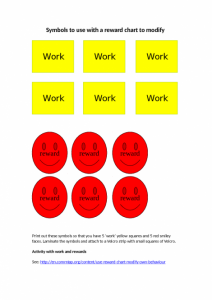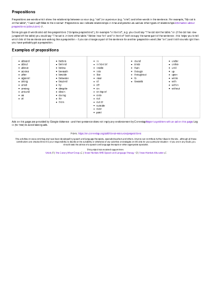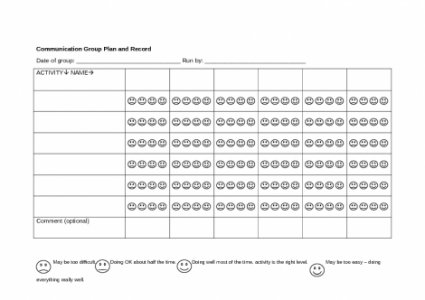Search
User login
Topic “Primary (5-11yrs)”
Primary school age (5-11 years)
Word Web Resources
Resources on this site for using word webs:
Symbols - overview and sources
Symbols, communication symbols or picture symbols, are a powerful and systematic support for communication.
Description
Communication symbols are sets of images which represent words and concepts in a language in a consistent way. They are designed for use with people having difficulties accessing text and for those with communication difficulties.
They can be used with:
Games and activities to help develop social skills
It can be difficult for some children to identify and understand social cues. To help develop the social growth of these children, there are lots of fun ways to help improve their social skills.
Games and activities to help develop social skills
Created 2 May 2012; updated 23 March 2022.
Coloured symbols for work and reward
Created 23 April 2012; updated 16 July 2015.
Prepositions
Prepositions are words which show the relationship between a noun (e.g. "cat") or a pronoun (e.g. "she") and other words in the sentence. For example, "My cat is on the table", "I went with Mike to the cinema". Prepositions can indicate relationships in time and position as well as other types of relationships. Information about prepositions (about.com).
Smiley face group progress sheet
Quick therapy/lesson evaluation sheet - using a rating scale of four smiley faces.
The idea is for the child/person to evaluate themselves in terms of how well they were able to do the activity. This helps the person running the activity to select harder or easier activities as time progresses - keeping them at a level where there is generally a high degree of success.
Created 16 February 2012; updated 16 July 2015.
Make a choice at snack time
| Activity/strategy name and materials required | How to do the activity | Key principles for doing the activity and comments |
|---|---|---|
| Snack activity Food items - in small pieces - which the children like, for example banana, apple, orange, crisps; Something uninteresting - e.g. a piece of paper; Pictures of the food items. |
| Key strategies - you may need to come back to these as and when necessary: Introduce each food item; Check which ones the child is interested in; Demonstrate the asking for and getting of an item - e.g. with another member of staff; Wait - give time for the child to respond or initiate; Offer a "forced alternative", e.g. "apple or orange?" - swap around the order in which you give the alternatives to check that the child is not just saying the last thing you say; Make it difficult for the child to communicate by pointing by having the choices close together and out of reach - so if they point you actually don't know which one they pointed to; Be sensitive to if the child is getting frustrated - think of ways to help them get it right first time - e.g. by reducing the choice down to one item (temporarily). Using forced alternatives: Always give the child the thing they said/signed for. If they are having difficulties with this - for example always say the last thing in the alternative, try the following: Have one of the forced alternatives being something uninteresting (e.g. the piece of paper); Have the last alternative as something the child doesn't want (if the child always says the last thing); Give more emphasis to the desired item, e.g. "Banana or paper?", you could also try only signing the desired item. Over time, reduce the difference in emphasis. Improving clarity Sometimes the child may say/sign what they want, but you don't feel it is clear enough (perhaps you can understand it in this context but might not be able to in another situation). To try and improve this, you can try: Saying 'pardon?' or something equivalent; Look confused and say, for example '(Do you mean) apple or banana?' (saying and signing these) - this will often encourage the child to produce a clearer version; Simply re-inforce with the clear version, e.g. you say "Oh, banana" (saying and signing it then passing it over); Try to avoid simply asking the child to repeat after you as there is no communication and it's not a natural way to communicate - by asking the child to repeat you have shown them that you have understood, and so this is now a different repetition activity - it also has the danger that it could reduce the accuracy of what the child originally said or signed as they didn't get a direct result from this.
|
Activities to develop understanding of a negative and a noun, e.g. "no hat"
| Activity/strategy name and materials required | How to do the activity | Key principles for doing the activity and comments |
|---|---|---|
| Dressing up - Some everyday clothes eg hat, gloves, scarf, sun glasses - Large soft toy - Digital camera or phone with a camera. |
| |
| - |
To use language to describe the characteristics and functions of objects
| Activity/strategy name and materials required | How to do the activity | Key principles for doing the activity and comments |
|---|---|---|
| What's in the bag? - Bag - A selection of objects or pictures - click below for printable object pictures: - Question prompt cards - click here to print.
| 1. Explain to your child/student that you are all going to take it in turns to put something in the bag and describe it for others to guess. 2.Model the game for the first turn. Give a description of your obejct for the others to guess. 3. Swap and let your child/student have a turn. If your child/student is finding it hard to think of things to saym you can use the questions cards to help support them. | |
| Treasure Hunt - Objects to hide around the room (optional) | ||
| Taboo! . |
Key Word Signing
Key word signing is used with people with communication and/or learning difficulties. Key word signing is always done whilst speaking, and you use it to sign the most important words that you are saying at an appropriate level for the person you are signing with.
Support Commtap to keep it online
Thank you for visiting Commtap.
Please read this message as it is extremely important.
- Visitor donations mean we can continue to host over 1,000 free activities to support speech, language, and communication development.
- Visitor donations mean we can continue to provide free resources to address a wide range of communication needs, including limited speech or language, interaction challenges, and needs associated with conditions such as developmental language disorder, autism, and cerebral palsy.
- Visitor donations mean we can continue to provide resources to support the work of speech and language therapists, teachers, teaching assistants, parents, and carers.
- Visitor donations mean we can continue to provide the free key word sign dictionary (bks.org.uk) which has over 2,000 Makaton and Signalong signs.
We know that not everyone is able to afford to pay to access these resources, however, if you can, please make a donation to keep the site going.
Thank you
Google ads on this page are provided by Google Adsense - and their presence does not imply any endorsement by Commtap. Report a problem with an ad on this page. Log in (for free) to avoid seeing Google ads.







